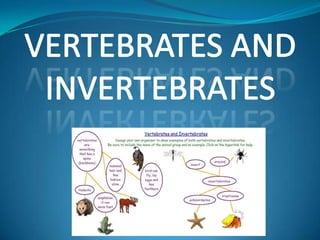
Vertebrates and invertebrates
- 2. All animal can be classified as belonging to one of two groups: Those with backbones Those without backbones Animals without backbones are called Invertebrates There are many different types of invertebrates: Sponges Are simple animals Have no backbone Anemones and Jellyfish Have tentacles and stinging cells All live in water Feed themselves with their tentacles Have no backbone Worms Snails, clams and octopuses Often have shells Have a head, foot and well developed organs Have no backbone Starfish and Urchins Have a spiny body Live on the bottom of the Ocean Have no backbone Insect, Spiders, Ticks, Lobsters, Crabs and Crayfish Have a shell like covering called an exoskeleton Have joined legs. Have a segmented body Animals with backbones are called Vertebrates There are five groups of vertebrates: Fish Are cold-blooded Live in water Have backbone These are fish:
- 4. Reptiles Have scales Live on land Are cold-blooded Usually lay eggs Have backbone These are reptiles:
- 6. Amphibians Are cold blooded Live on land and in water Have smooth skin Lay eggs These are amphibians
- 7. Amphibians have backbone: Birds Have feathers Are warm-blooded Have hollow bones and most can fly Lay eggs Birds have backbone:
- 8. Mammals Have hair or fur Are warm-blooded Feed milk to their young Bear live young (except monotremes) Mammals have backbones
- 9. VERTEBRATES Animals with an internal skeleton made of bone are called vertebrates. Vertebrates include fish, amphibians, reptiles, birds, mammals, primates, rodents and marsupials. Although vertebrates represent only a very small percentage of all animals, their size and mobility often allow them to dominate their environment. Click on the picture or name of the animals below for more information.
- 12. We are vertebrates and have a skeleton to keep us upright and to help us to move.
- 13. VERTEBRATES ARE ANIMALS WITH BACKBONES
- 14. The female lays the eggs and the young hatch from these. The young are cared for by the adult birds until they are old enough to fend for themselves.
- 16. venture on to land. They emerged from the oceans over 300 million years ago. Frogs, toads and salamanders are amphibians.
- 18. INVERTEBRATES Of the million or more animal species in the world, more than 98% are invertebrates. Invertebrates don't have an internal skeleton made of bone. Many invertebrates have a fluid-filled, hydrostatic skeleton, like the jelly fish or worm. Others have a hard outer shell, like insects and crustaceans. There are many types of invertebrates. The most common invertebrates include the protozoa, annelids, echinoderms, mollusks and arthropods. Arthropodsincludeinsects, crustaceans and arachnids.
- 21. This is the common name for 9 000 species of invertebrate animals found in all oceans of the world. These include: Coral, jellyfish and sea-anenome. Some are cylindrical with the mouth and tentacles at one end. Jellyfish look like an opened umbrella with tentacles hanging. All coelenterates capture their prey in the tentacles and then kill them with poison from the stinging organ.